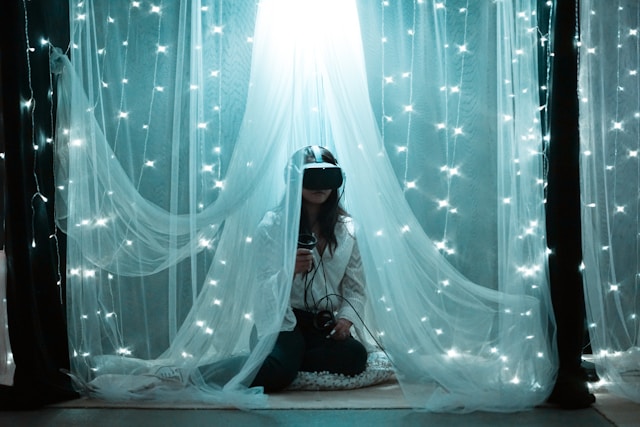Lifestyle
Combining mindfulness and movement in virtual environments

Transformative power of combining mindfulness and movement in virtual environments. Innovative products help users seamlessly integrate these practices into their daily routines, improving mental and physical well-being. Using cutting-edge technology, we create immersive experiences that make mindfulness and movement accessible to everyone, wherever they are.
In today’s fast-paced world, finding time for self-care can be a challenge. That’s why we’ve designed our virtual environments to fit effortlessly into busy schedules and provide a haven for relaxation and rejuvenation. Whether you want to reduce stress, improve focus or improve overall health, our solutions provide a holistic approach to wellness that is both effective and enjoyable.
Simulator equipment
Simulator HQ offers advanced simulator equipment designed for VR mindfulness. This equipment includes high-resolution VR headsets, motion sensors and interactive software that support mindfulness training. Our setups facilitate various mindfulness interventions, including VR-guided yoga and tai chi. These tools allow users to practice mindfulness effectively, improving their overall experience.
The rise of virtual environments in mindfulness practice
Mindfulness exercises in virtual environments have gained popularity. Virtual reality (VR) technology allows users to immerse themselves in soothing experiences without leaving their home. This shift helps integrate mindfulness effortlessly into daily routines.
Virtual reality allows practitioners to participate in mindfulness meditation sessions under the guidance of experts. These VR experiences make it easier to focus on the present moment, reducing stress more effectively than traditional methods. By using a VR headset, users can block out distractions and fully participate in their mindfulness training.
Studies have shown that VR mindfulness interventions can improve overall well-being. For example, a mixed methods study found that participants experienced significant reductions in anxiety and improvements in focus through VR-based mindfulness programs. This technology supports a more immersive and impactful mindfulness experience.
As we continue to explore the benefits of combining mindfulness and exercise in virtual environments, it is becoming clear that VR is revolutionizing the way we practice mindfulness. Embracing these digital tools can lead to better mental and physical health outcomes.
Benefits of mindfulness in virtual environments
Integrating mindfulness into virtual environments offers significant benefits for mental health and well-being. Using virtual reality to practice mindfulness creates an immersive experience that enhances traditional methods.
Conscious movement
Mindful exercise in virtual environments combines physical activity with mindfulness exercises. This approach promotes body awareness and increases overall physical well-being. For example, VR-guided yoga or tai chi sessions allow users to perform exercises precisely, leading to better posture and flexibility. Additionally, such practices help cultivate a sense of presence and mindfulness, reducing distractions and improving the overall experience.
Reduce stress
Reducing stress is a major benefit of using VR mindfulness. Immersive VR meditation sessions allow users to disconnect from real-world stressors, creating a calm and controlled environment. Research shows that even short VR mindfulness sessions can lower cortisol levels and promote relaxation. By using VR headsets, users can practice mindfulness more effectively, experiencing immediate stress relief and mental clarity. Consistent VR mindfulness training can also promote long-term resilience to stress.
Tools and technologies for virtual mindfulness
Virtual reality tools help integrate mindfulness with exercise, improving mental and physical well-being.
Golf simulator from Simulator HQ
Golf Simulator combines the essence of mindfulness exercises with physical movement in a virtual environment. Using advanced VR headsets, users immerse themselves in a realistic golf game. This immersive VR experience allows them to focus on precise movements, improving their state of mindfulness. Data shows that virtual golf helps reduce stress and improve concentration.
Mindfulness training in virtual environments
Mindfulness training in virtual environments uses immersive technology to improve mental health. Combining movement and mindfulness in VR provides effective stress reduction and focus improvement.
Guided Mindfulness Sessions
Guided mindfulness sessions in VR provide a structured approach to practicing mindfulness. Virtual reality headsets create an immersive experience, making it easier to stay focused. For example, users can participate in VR-guided yoga and tai chi sessions designed to promote relaxation. The experience is enriched by real-time motion tracking and high-resolution displays that capture precise movements.
Mindfulness skills training
Mindfulness skills training in virtual environments helps users develop essential mindfulness techniques. VR mindfulness interventions use interactive software to simulate different scenarios, encouraging present-moment awareness. Sessions often include guided meditations and breathing exercises, which improve state mindfulness. By integrating VR headsets, users experience an immediate mental shift, promoting consistent practice and building resilience to everyday stressors.
Impact of virtual environments on mindfulness practices
Virtual environments are transforming mindfulness practices by offering immersive and engaging experiences. Virtual reality (VR) helps integrate mindfulness into everyday life, creating new avenues for mental well-being.
State mindfulness
State mindfulness reflects awareness of current experiences. Virtual reality reinforces this through guided VR mindfulness sessions. Users experience the present moment with real-time feedback, promoting relaxation and focus. Immersive VR headsets make it easier to maintain mindfulness by reducing external distractions. While users practice mindfulness in a VR environment, they benefit from a sensory environment that deepens the mindfulness practice.
Property Mindfulness
Signature mindfulness refers to the consistent ability to remain mindful over time. Using VR systems for mindfulness training helps develop this trait through regular practice. VR-based mindfulness interventions create structured sessions that users can follow, promoting long-term habits. Over time, these practices reduce stress and improve mental clarity. VR mindfulness tools track progress and adjust difficulty levels, ensuring continued engagement and growth in trait mindfulness.

Challenges and considerations
Combining mindfulness and exercise in virtual environments poses several challenges and considerations. We need to address these to ensure effective mindfulness practices and user engagement.
Accessibility
Accessibility remains a major challenge when using virtual reality (VR) for mindfulness practice. VR headsets and related equipment can be expensive, which limits their reach. Additionally, users with disabilities may experience difficulty navigating these systems. It is crucial to ensure that VR platforms include adjustments for different needs.
Effectiveness
The effectiveness of VR-based mindfulness interventions varies. While immersive VR environments improve state mindfulness, the long-term impact on trait mindfulness requires further investigation. Systematic reviews show that while VR can reduce stress and improve focus in the short term, more longitudinal studies are needed to validate lasting benefits.
Future of mindfulness in virtual environments
The future of virtual reality for mindfulness practice promises countless innovations to improve mental well-being. Continuous improvements aim to make VR mindfulness sessions even more effective and accessible.
Innovations and trends
Current trends in VR-based mindfulness include adaptive AI virtual coaches for personalized experiences, multisensory feedback to deepen immersion, and more affordable VR headsets that make technology accessible to a wider audience. These innovations indicate a promising future for mindful action in virtual environments, ensuring more effective stress reduction and focus improvement.
Research and development
Research continues to investigate the effectiveness of VR mindfulness interventions. Studies focus on long-term benefits and optimal practices for maintaining state and trait mindfulness. Developers are working with psychologists to validate VR mindfulness training, hoping to create guidelines that maximize the potential of these virtual sessions for stress reduction and improving mental clarity.
Conclusion
Combining mindfulness and exercise in virtual environments offers a transformative approach to mental and physical well-being. As we continue to explore the potential of VR technology, the benefits of immersive mindfulness practices are becoming increasingly apparent.
By integrating these advanced tools into our daily routines, we can foster long-term habits that promote relaxation and mental clarity. As research continues, we expect even more effective and accessible solutions for improving mindfulness in virtual spaces.













